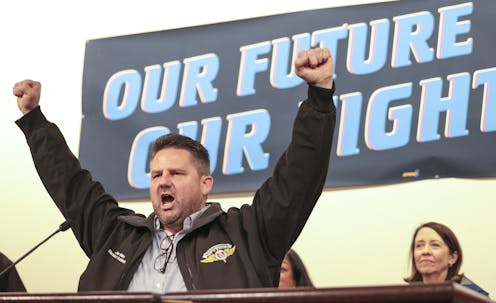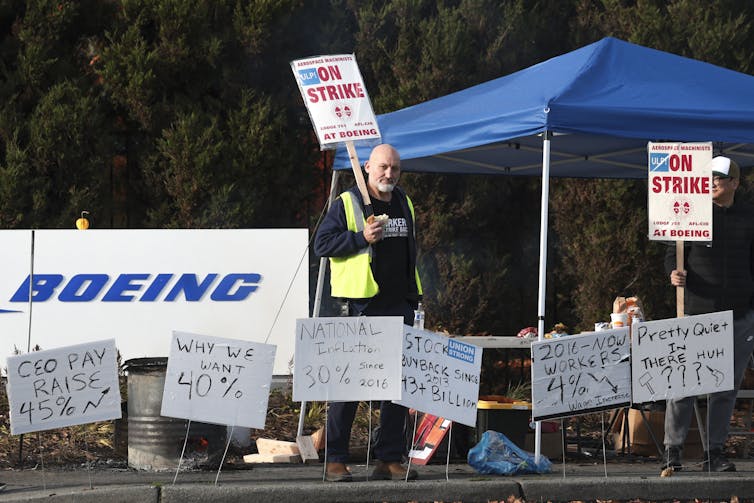Boeing workers secure big gains after strike, but the future for organized labor under Trump is uncertain
- Written by Jake Rosenfeld, Professor of Sociology, Washington University in St. Louis
 Jon Holden, a leader of Boeing workers belonging to a labor union, speaks at a rally on Oct. 15, 2024.Jason Redmond/AFP via Getty Images
Jon Holden, a leader of Boeing workers belonging to a labor union, speaks at a rally on Oct. 15, 2024.Jason Redmond/AFP via Getty ImagesStriking Boeing machinists approved a new contract on Nov. 4, 2024. It was negotiated between their union, the International Association of Machinists and Aerospace Workers, and the nation’s largest commercial aircraft manufacturer.
Members of the union, known as the IAM, won a 43% cumulative wage raise over the next four years, substantial signing bonuses, increased company contributions to workers’ 401k plans and a commitment by Boeing to build its next plane in the Seattle region.
The workers had rejected two previous proposals, demanding higher pay, job security and the return of a traditional pension plan before backing the third on the eve of Election Day.
Nearly 60% of the roughly 33,000 workers accepted the contract, ending a strike that had dragged on for nearly seven weeks, idling plane production and contributing to Boeing’s more than US$6 billion in losses in the past three months.
Boeing says its machinists will earn an average of $119,309 per year with this new contract, up from of $75,608 annually.
I’m a professor who has researched organized labor for two decades. Because the Boeing machinists won much of what they originally demanded, I see much in common between this deal and the contracts that ended or averted strikes at UPS and Detroit’s three big automakers in 2023.
But it’s not clear that these kinds of union wins will continue in President-elect Donald Trump’s second administration. Based on his recordand his rhetoric, it’s reasonable to expect Trump will make it harder for workers to join unions and will take other steps to weaken the power of organized labor.
2 big differences
I also see two big differences between those earlier contracts and what the workers agreed to this time. First, the Boeing strike was more contentious.
By rejecting two prior contract agreements, workers expressed anger and impatience not only at Boeing executives but at their own union. In September, the IAM presented its members with a proposal the union described as “the best contract we’ve negotiated in our history.” But 95% of the union’s members disagreed, rejecting the agreement, and 96% subsequently voted to authorize a strike.
It’s rare for union members to overwhelmingly rebuff their leadership that way. And yet it happened again a month later. In late October, workers turned down another proposal agreed to by the IAM and Boeing representatives, although by a smaller margin.
A key sticking point in the prior rounds of negotiation highlights the second distinguishing factor of the machinists’ strike. In 2013, the company demanded workers relinquish their defined-benefit pensions.
Because the company threatened to shift production of a then-new airplane away from the Seattle region if workers didn’t ratify the change, the rank and file reluctantly agreed to the proposal. They approved that contract by a narrow margin in January 2014.
 Boeing machinist Andre Johnstone pickets outside the company’s Renton production facility on Nov. 3, 2024, when some 33,000 workers were on strike.Jason Redmond/AFP via Getty Images
Boeing machinist Andre Johnstone pickets outside the company’s Renton production facility on Nov. 3, 2024, when some 33,000 workers were on strike.Jason Redmond/AFP via Getty ImagesA rallying cry
Restoring the lost pension plan became a rallying cry in this labor dispute.
For weeks, it appeared that the machinists would reject any contract that didn’t include a defined-benefit pension plan. These plans guarantee workers a set amount of money during their retirement years. Companies are responsible for ensuring they have sufficient funds to cover the costs.
These plans were commonplace in the mid-20th century. Today, defined-benefit plans are exceedingly rare. They’ve largely been replaced by defined-contribution plans, such as 401ks.
Defined-contribution plans shift the risk of retirement from the employer’s balance sheets onto the employee. Employers have to contribute only a certain amount of money to their workers’ own retirement accounts each pay period. These plans tend to be cheaper to administer and less risky for the employers.
That helps explain why the share of Americans enrolled in them has ballooned, while the fraction of workers with defined-benefit pension plans has cratered.
Long-term trends
In other recent labor battles, unions have demanded a restructuring of the company’s retirement plan, only to drop the demand as negotiations move forward. The call for a traditional pension serves as a bargaining chip, more or less.
But with the Boeing dispute, the demand appeared much more serious. In the end, the company didn’t budge on this issue, although it did agree to boost its contributions to workers’ individual retirement accounts.
Had Boeing restored its defined-benefit plan, it would have stood alone among other big employers facing labor disputes – and bucked a decades-long trend in corporate cost-cutting strategies. Its refusal to do so likely helps account for the sizable minority of workers who voted against the final proposal.
Despite the contentiousness of the strike and the company’s unwillingness to agree to all of the workers’ major demands, the Boeing strike – one of the most costly U.S. labor disputes in a quarter-century – will be remembered as yet another win for organized labor during these years of labor resurgence.
Yet these contract wins at Boeing, UPS, General Motors and the other two big Detroit automakers, and beyond, expose the limits of organized labor’s power today.
These workers belong to unions organized decades ago, and they’ve obtained higher pay and much better benefits through collective bargaining on new contracts. But increasing the number of U.S. workers represented by unions remains difficult.
The percentage of U.S. workers belonging to a union continues to shrink, declining to 10% of the labor force in 2023.
As Joe Biden, arguably the most pro-labor president since Franklin Delano Roosevelt, departs the White House, and Donald Trump’s team gets ready to move back in, I believe that prospects for the growth in union members in the near future appear exceedingly bleak.
Jake Rosenfeld does not work for, consult, own shares in or receive funding from any company or organization that would benefit from this article, and has disclosed no relevant affiliations beyond their academic appointment.
Authors: Jake Rosenfeld, Professor of Sociology, Washington University in St. Louis

